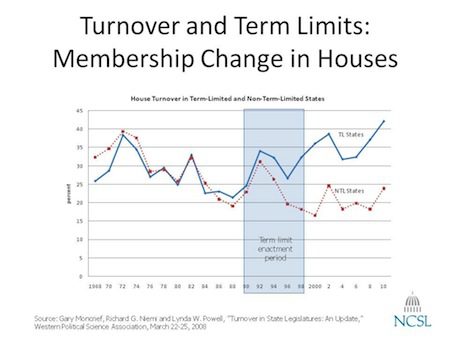Statehouse Turnover: Bellwether of the GOP Reckoning?
A story on the front page of USA Today this morning described a growing trend of high rates of turnover among state legislatures:
Roughly half of the nation’s 7,383 state legislators could have two years or less of experience after the 2012 elections, potentially making the next crop of lawmakers the greenest in a half-century, according to the National Conference of State Legislatures.
The high turnover, a result of the Republican surge in 2010, redistricting and term limits, comes as states struggle to recover from the Great Recession of 2007-2009.
It also reflects the divide between two political forces: “throw the bums out” vs. the public’s demand to fix problems, from escalating health care costs to education funding.
Karl Kurtz and Tim Storey, the authors of the study, predict that between this year’s election and 2010, the rate of turnover will “almost certainly” be the highest in 50 years.
They acknowledge that term limits have contributed to the higher rates of turnover (see chart) but,
We suggest that it is more due to the Republican sweep of 2010 and redistricting in 2012 than it is term limits and redistricting. … the waves of turnover come in different years in different states and cannot by itself account for the anticipated 2010-12 turnover phenomenon.
This is partially due to the observation that since term limits have been enacted in 15 states, the rate of turnover between states with and without term limits has remained fairly stable. Vide this chart:
The GOP controls the majority of state legislatures across the country (27), and the Democratic Party controls fifteen, which often translates into more authority when it comes to redistricting. According to the Cook Political Report, Republicans have redistricting authority in four times more congressional districts than the Democrats.
Regardless, as the NCSL folks acknowledge, redistricting and term limits only explain the trend up to a point. If redistricting has much of an impact it will benefit the Republicans disproportionately–they get to draw and approve the maps–which will to some degree help consolidate their majorities. But redistricting cuts both ways; legislators in safer seats are more able to buck the party line and are less susceptible to the alleged corrupting effects of outside money. Also, a more cumbersome party could exacerbate the tension between the establishment and grassroots, and might hasten the “fearless searching moral inventory” which for a party addicted to big government but energized by uncompromising small-government activists, seems inevitable.
But do either of those macro sentiments really animate either local voters or the candidates themselves? It sure seems like it in Des Moines:
Republican Party of Iowa activists on Saturday approved a lengthy party platform encompassing 27 separate policy areas, some of which featured dozens of specific positions.
The individual planks in many cases reflected the party’s bedrock social and fiscal conservatism, but also belied the libertarian streak represented by the Ron Paul supporters who crowded the party convention.
And in Washington state:
In years past, party officials were usually happy to get just one person to file for each of the precinct slots. But of the 55 open Republican PCO seats in Cowlitz County this year, 36 are contested. By comparison, only four of 27 Democratic PCO seats are challenged.
State Republican officials said they saw the same thing all over Washington during last week’s filing period.
“We’ve never seeing this kind of interest,” said Kirby Wilbur, chairman of the state Republican Party.
Or in this Washington Post story:
In Maine, 21-year-old Ron Paul supporter Ashley Ryan was elected the state’s new Republican national committeewoman …
That’s in addition to taking top roles in state party organizations, in states such as Iowa, and inspiring statehouse candidates around the country. For instance, A.J. Spiker, who ran Paul’s campaign for Iowa’s leadoff nominating caucuses, was elected state GOP chairman in February.
Louisiana GOP officials and Paul supporters tangled during a raucous June 2 convention that devolved into two separate conventions and separate delegate slates. Two Paul backers were arrested after they refused to leave.
Obviously, Ron Paul and the liberty movement don’t explain the trend entirely. But redistricting–which could actually increase the intra-party tension–and term limits aside, the engagement of conservatives in local and state elections is the sine qua non of high statehouse turnover.

Comments